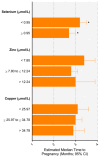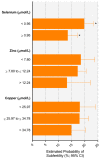Maternal Selenium, Copper and Zinc Concentrations in Early Pregnancy, and the Association with Fertility
- PMID: 31315178
- PMCID: PMC6683068
- DOI: 10.3390/nu11071609
Maternal Selenium, Copper and Zinc Concentrations in Early Pregnancy, and the Association with Fertility
Abstract
Trace elements such as zinc, copper, and selenium are essential for reproductive health, but there is limited work examining how circulating trace elements may associate with fertility in humans. The aim of this study was to determine the association between maternal plasma concentrations of zinc, copper, and selenium, and time to pregnancy and subfertility. Australian women (n = 1060) who participated in the multi-centre prospective Screening for Pregnancy Endpoints study were included. Maternal plasma concentrations of copper, zinc and selenium were assessed at 15 ± 1 weeks' gestation. Estimates of retrospectively reported time to pregnancy were documented as number of months to conceive; subfertility was defined as taking more than 12 months to conceive. A range of maternal and paternal adjustments were included. Women who had lower zinc (time ratio, 1.20 (0.99-1.44)) or who had lower selenium concentrations (1.19 (1.01-1.40)) had a longer time to pregnancy, equivalent to a median difference in time to pregnancy of around 0.6 months. Women with low selenium concentrations were also at a 1.46 (1.06-2.03) greater relative risk for subfertility compared to women with higher selenium concentrations. There were no associations between copper and time to pregnancy or subfertility. Lower selenium and zinc trace element concentrations, which likely reflect lower dietary intakes, associate with a longer time to pregnancy. Further research supporting our work is required, which may inform recommendations to increase maternal trace element intake in women planning a pregnancy.
Keywords: copper; fertility; pregnancy; selenium; subfertility; time to pregnancy; trace elements; zinc.
Conflict of interest statement
The authors declare no conflict of interest. The funders had no role in the design of the study, in the collection, analyses, or interpretation of data, in the writing of the manuscript, or in the decision to publish the results.
Figures
Similar articles
-
Maternal selenium, copper and zinc concentrations in pregnancy associated with small-for-gestational-age infants.Matern Child Nutr. 2014 Jul;10(3):327-34. doi: 10.1111/j.1740-8709.2012.00430.x. Epub 2012 Jul 12. Matern Child Nutr. 2014. PMID: 22784110 Free PMC article.
-
Assessment of plasma and red cell trace element concentrations, disease severity, and outcome in patients with critical illness.J Crit Care. 2014 Apr;29(2):214-8. doi: 10.1016/j.jcrc.2013.10.012. Epub 2013 Oct 29. J Crit Care. 2014. PMID: 24388658
-
A Prospective Study of Serum Trace Elements in Healthy Korean Pregnant Women.Nutrients. 2016 Nov 23;8(11):749. doi: 10.3390/nu8110749. Nutrients. 2016. PMID: 27886083 Free PMC article.
-
Are copper, zinc and selenium in erythrocytes valuable biological indexes of nutrition and pathology?J Trace Elem Med Biol. 1999 Nov;13(3):113-28. doi: 10.1016/S0946-672X(99)80001-7. J Trace Elem Med Biol. 1999. PMID: 10612074 Review.
-
The role of copper, molybdenum, selenium, and zinc in nutrition and health.Clin Lab Med. 1998 Dec;18(4):673-85. Clin Lab Med. 1998. PMID: 9891606 Review.
Cited by
-
Zinc transporters ZIPT-2.4 and ZIPT-15 are required for normal C. elegans fecundity.J Assist Reprod Genet. 2022 Jun;39(6):1261-1276. doi: 10.1007/s10815-022-02495-z. Epub 2022 May 1. J Assist Reprod Genet. 2022. PMID: 35501415 Free PMC article.
-
Assessment of Iodine and Selenium Nutritional Status in Women of Reproductive Age in Latvia.Medicina (Kaunas). 2021 Nov 5;57(11):1211. doi: 10.3390/medicina57111211. Medicina (Kaunas). 2021. PMID: 34833429 Free PMC article.
-
Can Nutrition Help in the Treatment of Infertility?Prev Nutr Food Sci. 2021 Jun 30;26(2):109-120. doi: 10.3746/pnf.2021.26.2.109. Prev Nutr Food Sci. 2021. PMID: 34316476 Free PMC article. Review.
-
Minerals and the Menstrual Cycle: Impacts on Ovulation and Endometrial Health.Nutrients. 2024 Mar 29;16(7):1008. doi: 10.3390/nu16071008. Nutrients. 2024. PMID: 38613041 Free PMC article. Review.
-
Selenium Nutritional Status Assessment in Chinese Adult Females: Results from the China Nutrition and Health Surveillance in 2015.Nutrients. 2025 Apr 24;17(9):1427. doi: 10.3390/nu17091427. Nutrients. 2025. PMID: 40362735 Free PMC article.
References
-
- World Health Organisation. [(accessed on 6 May 2017)];2015 Available online: http://www.who.int/reproductivehealth/topics/infertility/definitions/en/
MeSH terms
Substances
Grants and funding
- GNT1099422/National Health and Medical Research Council
- University of Adelaide/Lloyd Cox Obstetrics and Gynaecology Professorial Research Fellowship
- ID1070421/National Health and Medical Research Council
- University of Adelaide/Robinson Research Institute Career Development Fellowship
- University of Adelaide/Lloyd Cox Research Fellowship
LinkOut - more resources
Full Text Sources
Medical



